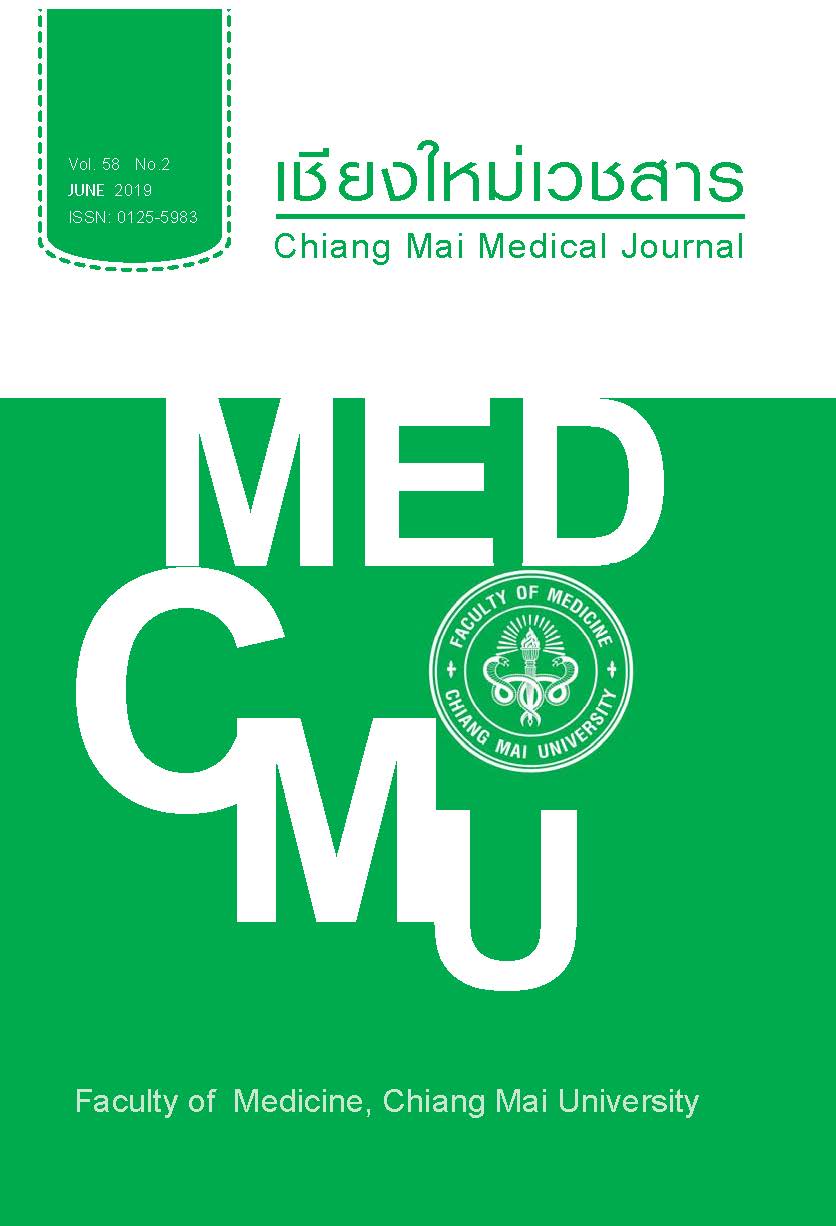Incidence of parasitic infections of in- and outpatients at Maharaj Nakorn Chiang Mai hospital, Chiang Mai University, Thailand 2012-2016
Keywords:
Parasitic infection, Maharaj Nakorn Chiang Mai HospitalAbstract
Objective The objective of this study was to determine the incidence of parasitic infections in in- and out-patients at Maharaj Nakorn Chiang Mai Hospital, Chiang Mai University, Thailand during the period 2012 through 2016.
Methods Stool, blood, and sputum samples of patients were examined for parasite infections at the laboratory of the Department of Parasitology, Faculty of Medicine, Chiang Mai University. Stool samples were examined for intestinal parasites using the formalin-ether concentration technique, modified acidfast staining, and simple smears. Stool and sputum samples were cultured for Strongyloides stercoralis using an agar plate technique. Blood samples were examined for malarial parasites using Giemsa staining of thick blood films.
Results During the five year study period, a total of 18,967 stool specimens were examined of which 1,268 (6.69%) were positive for at least one intestinal parasite. Helminthic infections were found in 6.02% of cases and 0.67% had protozoan infections. The most frequent helminth and protozoa among infected patients were S. stercoralis (58.60%) and Giardia lamblia (4.18%). The prevalence of malaria infection was 2.94%, with a higher positive rate for Plasmodium vivax (1.99%) than P. falciparum (0.95%). The annual incidence of intestinal parasites during the period 2012 through 2016 decreased significantly from 7.99% to 5.78%. Malaria infections between 2013 and 2016 also decreased from 3.23% to 1.76%, but the change was not statistically significant.
Conclusion There has been a decrease in the incidence of parasitic infections in patients presenting at the hospital over the study period. This may reflect improvement of the hygiene of people in northern Thailand in general. However, this information may not be representative of the parasitic infection situation of particular groups, e.g., hill tribe communities and other groups living in isolated rural areas.
References
Upatham ES, Viyanant V, Kurathong S, Rojborwonwitaya J, Brockelman WY, Ardsungnoen S, et al. Relationship between prevalence and intensity of Opistorchis viverrini infection, and clinical symptoms and signs in a rural community in north-east Thailand. Bull WHO. 1984;62;451-61.
Kullavanijaya P, Tangkjivanich P, Poovorawan Y. Current status of infection-related gastrointestinal and hepatobiliary diseases in Thailand. Southeast Asian J Trop Med Public Health. 1999;30:96-105.
Soriano SV, Barbieri LM, Pierangeli NB, Giayetto AL, Manacorda AM, Castronovo E, et al. Intestinal parasites and the environment: frequency of intestinal parasites in children of Neuquen Patagonia, Argentina. Rev Latinoam Microbiol. 2001;43:96-101.
Wiwanitkit V. Intestinal parasitic infections in Thai HIV-infected patients with different immunity status. BMC Gastroenterol. 2001;1:3.
Waikagul J, Krudsood S, Radomyos P, Radomyos B, Chalemrut K, Jonsuksuntigul P, et al. A cross-sectional study of intestinal parasitic infections among schoolchildren in Nan province, northern Thailand. Southeast Asian J Trop Med Public Health. 2002;33:218-23.
Saksirisampant W, Prownebon J, Kulkumthorn M, Yenthakam S, Janpla S, Nuchprayoon S. The prevalence of intestinal parasitic infections among school children in the central region of Thailand. J Med Assoc Thai. 2006;89:1928-33.
Ngrenngarmlert W, Lamom C, Pasuralertsakul S, Yaicharoen R, Wongjindanon N, Sripochang S, et al. Intestinal parasitic infections among school children in Thailand. Trop Biomed. 2007;24:83-8.
Jongsuksantigul P, Chaeychomsri W, Techamontrikul P, Jeradit P, Suratanavanit P. Study of prevalence and intensity of intestinal helminthiasis and opisthrochiasis in Thailand. J Trop Med Parasitol. 1997;15:80-95.
Triteeraprapab S, Jongwutiwses S, Chanthachum N. The prevalence rates of human intestinal parasites in Mae-la-moong, Umphang District, Tak Province, a rural area of Thailand. Chula Med J. 1997;41:649-58.
Triteeraprapab S, Nuchprayoon I. Eosinophilia, anemia, and parasitism in a rural region of northwest Thailand. Southeast Asian J Trop Med Public Health. 1998; 29:327-32.
Triteeraprapab S, Akrabovorn P, Promtrng J, Chuenta K. High prevalence of hookworm infection in a population of northeastern Thailand after and Opisthorchiasis control program. Chula Med J. 1999;43:99-108.
Yahom S, Kullawat J, Boonsai D, Chatuphonprasert W, Thanchomnang T, Radomyos P. The prevalence of intestinal parasitic infections in Maha Sarakham and Kalasin provinces. J Trop Med Parasitol. 2013;36:29-33.
Thitasut P, Bangxana H, Yasmuth C, Sivasomboon C Doege TC. A survey of intestinal parasite, Chiang Mai, Thailand. Chiang Mai Med Bull. 1973;12:99-122.
Yamuth C, Sukhawat K. A study of intestinal parasites among Karen school children of Samerng and Maecham District, Chiang Mai, Thailand. Chiang Mai Med Bull. 1990;29:33-40.
Piangjai S, Sukontason K, Sukontason KL. Intestinal parasitic infections in hill-tribe schoolchildren in Chiang Mai, northern Thailand. Southeast Asian J Trop Med Public Health. 2003;34 Suppl 2:90-3.
Malaria Division, Department of Communicable Disease Control, Ministry of Public Health. Annual report 2016. Bangkok: The War Veterans Organization of Thailand 2016 (in Thai).
Ministry of Public Health. [cited 2017 Nov 1]. Available from: https://www.thaivbd.org/n/histories/view/2695.
World Health Organization. Basic laboratory methods in medical parasitology. 1991. p. 16.
Koga K, Kasuya S, Khamboonruang C, Sukhavat K, Ieda M, Takatsuka N, et al. A modified agar plate method for detection of Strongyloides stercoralis. Am J Trop Med Hyg. 1991;45:518–21.
Pungpak S, Radomyos P, Radomyos B, Schelp FP, Jongsaksuntigul P, Bunnag D. Treatment of Opisthorchis viverrini and intestinal fluke infections with Praziquantel. Southeast Asian J Trop Med Public Health. 1998;29:246-9.
Radomyos B, Wongsaroj T, Wilairatana P, Radomyos P, Praevanich R, Meesomboon V. Opisthorchiasis and intestinal fluke infections in northern Thailand. Southeast Asian J Trop Med Public Health. 1998;29:123-7.
Kumchoo1 K, Wongsawad C, Chai JY, Vanittanakom P, Rojanapaibul A. High prevalence of Haplorchis taichui metacercaria in cyprinoid fish from Chiang Mai province, Thailand. Southeast Asian J Trop Med Public Health. 2005;36:451-5.
Sukontasan K, Piangjai S, Sukontasan K, Chaithong U. Potassium permanganate staining for differentiation the surface morphology of Opisthorchis viverrini, Haplorchis taichui and Phaneropsolus bonnei eggs. Southeast Asian J Trop Med Public Health. 1999;30:371-4.
Thaaenkham U, Visetsuk K, Dung DT, Waikagul J. Discrimination of Opisthorchis viverrini from Haplorchis taichui using COI sequence marker. Acta tropica. 2007;103:26-32.
Thairungroi M, Anantaphruti T. Current status of Taeniasis in Thailand. Korean J Parasitol. 2013; 51:37-42.
World Health Organization. [cited 2017 Nov 7]. Available from: https://www.who.int/malaria/mpac/mpac-sep2016-malaria-elimination-gms.pdf.
Downloads
Published
How to Cite
Issue
Section
License

This work is licensed under a Creative Commons Attribution-NonCommercial-NoDerivatives 4.0 International License.










